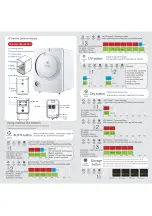
Installing the Autoloader: Dell PowerVault 124T DLT VS160 Autoloader User's Guide
file:///T|/htdocs/stor-sys/124T/en/124tvs16/install.html[12/5/2012 10:25:55 AM]
2. Identify the host adapter, channel number, target ID number, and LUN number for the first LUN of the device to be
configured. In this example, the Certance Ultrium 2 (a drive in the PowerVault 124T) is shown at the address, or nexus,
3 0 0 0 — which means host adapter 3, channel number 0, ID 0, and LUN 0. The PowerVault 124T always has the tape
drive at LUN 0 and the robot at LUN 1.
3. For each LUN that needs to be discovered by Linux, issue the following command:
echo "scsi -add-single-device H C I L">/proc/scsi/scsi
H C I L refers to the nexus described in
. So, with the PowerVault 124T robot configured at LUN 1, type:
echo "scsi -add-single-device 3 0 0 1">/proc/scsi/scsi
The echo command will force a scan of each device at the given nexus.
4. Type
cat /proc/scsi/scsi
again to verify that all devices are now listed. The output will look similar to the following:
Attached devices:
Host: scsi3 Channel: 00 Id: 00 Lun: 00
Vendor: Quantum Model: DLT VS160 Rev: 3100
Type: Sequential -Access ANSI SCSI revision: 03
Attached devices:
Host: scsi3 Channel: 00 Id: 00 Lun: 01
Vendor: DELL Model: PV-124T Rev: V31
Type: Sequential -Access ANSI SCSI revision: 03
Administrators should add the echo command to the Linux boot scripts because the device information is not persistent
and must be created each time the system boots up. One example file that can be used for storing the commands is
/etc/rc.local. Note that configuring additional devices on a server or a storage area network (SAN) can cause the
devices to be reordered, which requires administrators to modify the commands. If the Fibre Channel adapter supports
Persistent Bindings or an equivalent function, it can be enabled to reduce the chance of devices being reordered upon
discovery.
NOTE:
This procedure must be run each time the server is booted. Also, if backup application services are running (for
example, they automatically start when the OS loads), they must be disabled and re-enabled after the above procedure.
The other way to enable LUN support is to recompile the kernel and enable LUN scanning in the Adaptec driver, but it requires
advanced knowledge of Linux and will not be covered here. However, it will allow the server to always boot and see the
device without any manual procedures.
Enabling LUN Support in Netware
1. From the System Console, verify the LUN device is not being detected by using the list storage adapters command.
Typical output where only the tape drive is being recognized:
0x08 [V321 -A3] Adaptec SCSI Card 39160/3960D – Ultra160 SCSI [slot 201]
0x15 [V321 -A3-D5:0] Quantum DLT VS160 3100
0x09 [V321 -A4] Adaptec SCSI Card 39160/3960D – Ultra160 SCSI [slot 202]
2. From the System Console, type
nwconfig
.
3. Select
NCF files Options
from the Configuration Options screen.
4. Select
Edit STARTUP.NCF
from the Available NCF Files Options screen.
5. Add the
/LUNS
switch to the load line of the appropriate SCSI driver. If a dual channel card is installed and the user is
unsure which channel the LUN device is attached to, simply edit both lines.
LOAD ADPT160M.HAM SLOT=201 /LUNS
LOAD ADPT160M.HAM SLOT=202 /LUNS
6. After the STARTUP.NCF file has been edited, save the file and reboot the server to activate the new STARTUP.NCF.
7. Upon reboot navigate to the System Console and type
scan all
. This will start a scan of all the LUNS on each adapter.













































